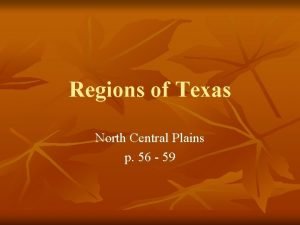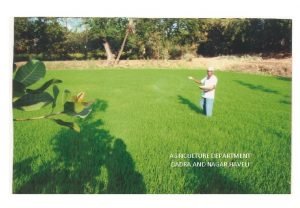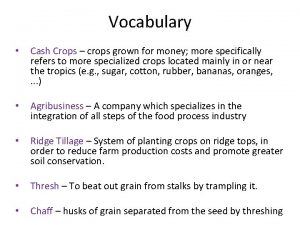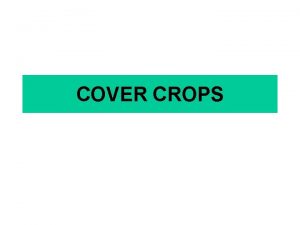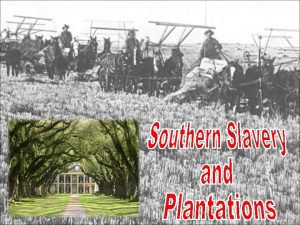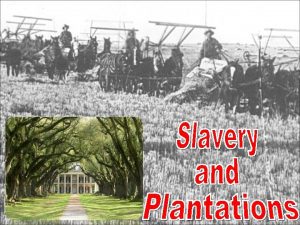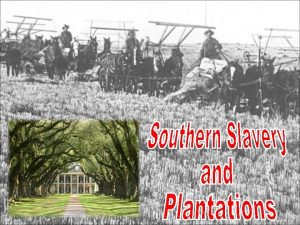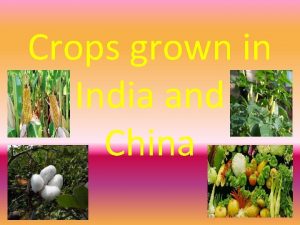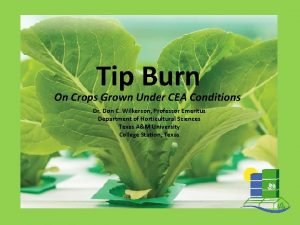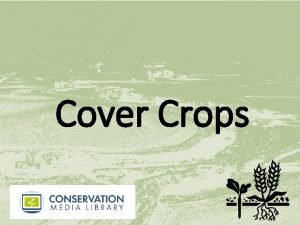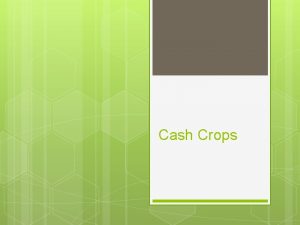Texas Crops 1800 1940 Cotton First grown in

















- Slides: 17

Texas Crops 1800 -1940

Cotton • First grown in Texas by Spanish missionaries – Reports date back to 1745 • Jared E. Groce brought cotton production to Texas in 1821 – Settled in Lower/Middle Brazos River Valley • Cotton replaces tobacco as #1 cash crop • Slave-based cotton plantations – South Central Texas on Lower Colorado, Brazos, and Trinity rivers – Blackland Prairies and Cross Timbers of North Central Texas

Cotton Slave Plantation Cotton Gin • Uses: – Clothing, linens, draperies, upholstery, carpet, nitrocellulose (used in explosives), and artificial plastic

Wheat • First grown commercially in Texas near Sherman about 1833 • Expanded greatly in North and Central Texas after 1850 • A new strain of wheat, the soft red winter wheat, spread across North West Texas between 1830 and 1890 – Very durable and heat-resistant strain

Wheat • Uses: Wheat was vital to the production of bread, as well as livestock feed

Sorghum • Introduced to Texas in 1879 by H. B. Pratt • The sorghum crop is important in the Rio Grande valley, in the coastal bend, on the Blacklands from San Antonio to Greenville, on the Rolling Plains, on the South Plains, and in the Panhandle • In Texas sorghum is primarily grown as forage for cattle, sheep, and horses and as grain to feed cattle, sheep, swine, horses, and poultry.

Sorghum • Mechanization in the 1930 s reduced the need for grain in feeding livestock, making it possible for sorghum to be used as a grain cash crop like wheat and cotton • In the 1940 s sorghum became the leading cereal crop in the state for the first time

Corn (Maize) • Corn in Texas dates all the way back to prehistoric times – Spanish explorers of the 1500 s found Indians already growing corn in East Texas and they then carried it to the Rio Grande Valley • Used as a basic ingredient in tortillas, tamales, posole, and atole

Corn (Maize) • Centuries later, Americans settling Texas would also rely on corn as a vital crop and incorporate it into the southern agricultural tradition • The newcomers used corn as a major source of food and the #1 feed crop

Corn (Maize) • They also used the cobs for jug and bottle stoppers, smoking pipes, tool handles, corn shellers, back scratchers, torches, fishing floats, firewood, and meat-smoking fuel • Even the stalks and leaves were used in sub-roofing, roof thatching, scarecrows, light fencing, erosion stoppage, and emergency material for the construction of shelter. • Grown primarily in the East half of Texas

Rice • The first major rice farmer in Texas was David French of Beaumont in 1863 • Commercial production really began in 1883 with the completion of the southern transcontinental railroad • Grown primarily on the coastal prairies and milled in Port Arthur, Beaumont, Orange, and Houston

Rice • Rice still remains an important crop in Texas and the state is still one of the top rice producers in the U. S. Rice Mill

Weathering the Weather • Farmers have faced problems with the weather throughout Texas history • Crops have suffered from too little rain some years, too much rain in others, and from damage caused by hail as well

Agricultural Pests Cotton Pests Wheat Pests Pink Bollworm Greenbug Boll Weevil Russian Wheat Aphid

Agricultural Pests Sorghum Pests Corn Pests Greenbug Corn Borer Rootworm Beetle Sorghum Midge

Agricultural Pests Rice Pests Pest Control • Pest control is a delicate issue because the methods have to work, be cost-effective, and safe for the agricultural product Stinkbug Rice Water Weevil • Biological control • Introducing the pests’ natural predators into the ecosystem • Plant-derived insecticides • Insect pheromones • Disrupt insects’ development

Modern Research: Bt Cotton/Corn • Bacillus thuringiensis (Bt) is a bacteria in soil that produces a toxin that is effective specifically against certain insects • Research in genetic engineering has allowed for the incorporation of the toxin-producing genes into cotton and corn plants, making them resistant to some important pests • This modern invention has cut down on the use of dangerous pesticides in some parts of the world
 North central plains texas agriculture
North central plains texas agriculture Shade grown coffee vs sun grown
Shade grown coffee vs sun grown Agri chemicals projects in dadra & nagar haveli
Agri chemicals projects in dadra & nagar haveli Cotton on the roadside cotton in the ditch
Cotton on the roadside cotton in the ditch Egyptian vs pima cotton
Egyptian vs pima cotton My grown up christmas list link
My grown up christmas list link Maui grown coffee
Maui grown coffee All grown up and no place to go
All grown up and no place to go Father of english drama
Father of english drama 59 swans poem
59 swans poem Fennec fox body parts
Fennec fox body parts Luciuis
Luciuis Frida kahlo self portrait with monkey 1940
Frida kahlo self portrait with monkey 1940 Que es una computadora
Que es una computadora Lahore prostab 1940
Lahore prostab 1940 Eniac full form in computer
Eniac full form in computer Ve day times square
Ve day times square Republic act no 5250
Republic act no 5250
